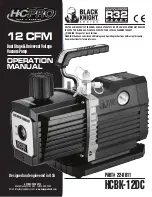
– 32 –
Hydro Unit
Installation Manual
10
Maintenance
Execute periodic maintenance at least once a year.
Check points
• Check all electrical connections and make adjustments if they are necessary.
• Check the water pipes of the heating systems in particular any evidence of leakage.
• Check the expansion tank inner pressure. If it is insufficient, enclose nitrogen or dry air in the tank.
• Check that the hydraulic pressure is 0.1 MPa (1 bar) or more with a build-in water manometer. If it is insufficient,
replenish tap water.
• Clean the strainer.
• Check the pump for an abnormal sound or other abnormalities.
• Operate the domestic hot water safety valve periodically to prevent lime scale blockage and to ensure proper
operation of the safety valve.
• In order to prevent corrosion of the enamelled hot water cylinder, a magnesium anode is installed in the tank.
The anode has a life expectancy of approximately 2-5 years depending on the water quality.
It is recommended to inspect the anode every year. This work has to be performed the a skilled service engineer.
Please see the following details.
Anode
In order to prevent corrosion of the enamelled hot
water cylinder, a magnesium anode is installed at the
centre top of the tank.
The anode has a life expectancy of approximately 2-5
years depending on the water quality.
It is recommended to inspect the anode every year.
Checking the anode
1. Disconnect the electrical power supply.
2. Remove the front panel.
3. Remove the centre insulation part at the top of the
water cylinder. This allows access to the anode
connection.
4. Disconnect the wire connection between the anode
and the tank (Refer to “Fig.10-01”).
5. Insert a multimeter (range mA) between the anode
and the tank. Anode current > 0.3 mA: Anode is
active and OK. Anode current < 0.3 mA: Anode
should be checked and possibly be replaced.
6. Reconnect the wire connection between the anode
and the tank. Reinstall the insulation part and close
the front cover. Reconnect the power supply.
▼
Fig.10-01
Replacing the anode
1. Disconnect the electrical power supply.
2. Remove the front panel.
3. Remove the centre insulation part at the top of the water cylinder. This allows access to the centre flange.
4. Close the cold water inlet at the ball valve on the domestic hot safety group.
5. Connect a water hose to the domestic hot water bleed valve next to the safety group. The hose outlet should be
at floor level. Lower the hose outlet into a bucket or locate it near a floor drain.
6. Open a hot water tapping point (to avoid vacuum in the water tank).
7. Open the bleed valve and ensure sufficient drainage of water to ensure that the water level in the tank is at least
10 cm below the top of the tank.
8. Remove the hot water outlet flexible pipe from the top of the tank flange by retrieving the connecting clip.
9. Remove the tank flange by means of 8 nuts.
10. Inspect and replace the anode if necessary.
11. Reinstall the flange, and the hot water flexible pipe. Always use a new gasket/spacer ring and new O-rings.
Ensure that the connection clip is properly re-installed.
12. Recommission the domestic hot water system as described in the section “Water charging - Domestic water”.
How to drain the water in the tank
Drain using the siphon principle.
Procedure
1. Connect the drain hose (size: 1/2 inch). Guide the drained side to a drainage ditch (A position lower than the
bottom of the AIO unit)
2. Open valve A and close valve B.
(Refer to “Fig.10-02”)
3. Open the domestic hot water outlet side to atmospheric pressure.
4. Apply negative pressure to the drain hose.
Once the water begins to drain, all the water in the tank can be drained by the siphon principle.
▼
Fig.10-02
Valve description
Valve B
Valve A
63-EN
64-EN
Содержание HWT-1101F21MM3W-E
Страница 39: ...0714305099 1 ...







































